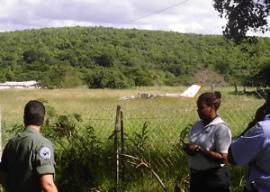
The NTSB is investigating the crash. It routinely posts preliminary reports of the circumstances of accidents within weeks of the event. The final report, which may determine the cause of the accident, typically takes up to a year to be released. The preliminary report, posted on the NTSB website, lays out the series of events leading up to the crash and relates the findings of the investigators on the scene.
The privately owned, single-engine Cessna 177 crashed shortly after taking off. Witnesses said the plane appeared to be in trouble almost immediately after takeoff, and people near the crash site told The Source the plane made a high-pitched shrieking sound moments before crashing into a small field on East Airport Road, about a half-mile south of the Queen Mary Highway.
Witness descriptions in the preliminary report also point to indications that the problem may have been mechanical.
The three men who died in the accident were identified by the V.I. Police Department as David Bentley, 58, of St. Croix; Elium King, 58, of St. Vincent; and Mark Atchley, 50, of Tennessee; according to a release from the department. The autopsy established that the three victims died instantly upon impact before the plane burst into flames.
Officials have not confirmed who the pilot of the plane was. However, the report described a pre-flight meeting taking place "in the pilot’s office." Bentley was the director of Caribbean Flight Center, a company that offered a variety of flight services at Rohlsen. The other two men were from off-island.
A police detective, who happened to be at the airport and saw the airplane take off, told investigators the plane appeared to be "straining to gain altitude," while "flying low at a straight angle." The detective also noted that the "the wings began moving up and down," and that the propeller was spinning. The airplane then "suddenly made a sharp left turn and went down," according to the detective.
Investigators also listened to the recorded transmissions from the control tower. According to the report, the controller cleared the airplane for takeoff at 1:28 p.m. Shortly thereafter, the controller asked, "three-four-three-one tango, are you experiencing any difficulty?" The plane’s response: "Yes we are; we’re gonna make a turn back."
There were no further transmissions from the airplane.
The tower controller told investigators, "Rotation [an aviation term for the upward pitch of an aircraft, particularly when starting the climb after takeoff] appeared unusual – slow and a nose-high pitch attitude, with an immediate dip of the right wing. Climb out was low and slow."
The airplane turned north about a quarter-mile past the end of the runway, and when it was about two miles northeast of the airport, it still appeared "low, slow, and in an unusually high pitch attitude."
After the controller asked the pilot if he was experiencing any difficulty, he advised the pilot to proceed as requested, and saw the airplane turn westbound, appearing to maintain a level altitude. The airplane then disappeared behind a hill and did not reappear. The controller tried to contact the pilot by radio, and when unable, initiated an emergency response.
"Another airplane subsequently departed the airport and reported that the crash site was two to three miles northeast of the airport, with the airplane on fire and no one observed outside," the NTSB report says.
The report says there was no evidence of ground scars attributed to the airplane outside the immediate area of the wreckage. All flight control surfaces were accounted for at the accident site.
The report then recounts the mechanical condition of the plane but draws no conclusions based on those findings. Everything from the scarring and gouging of the leading edges of the wings to the gap of the spark plugs is included.
The report also notes, "Baggage and contents remnants recovered from the airplane were mostly consumed by fire, to the extent that an accurate baggage weight prior to the accident could not be established."
Pilot of October Crash Was Trying to Return to Airport, NTSB Report Says
Keeping our community informed is our top priority.
If you have a news tip to share, please call or text us at 340-228-8784.
If you have a news tip to share, please call or text us at 340-228-8784.
Support local + independent journalism in the U.S. Virgin Islands
Unlike many news organizations, we haven't put up a paywall – we want to keep our journalism as accessible as we can. Our independent journalism costs time, money and hard work to keep you informed, but we do it because we believe that it matters. We know that informed communities are empowered ones. If you appreciate our reporting and want to help make our future more secure, please consider donating.





